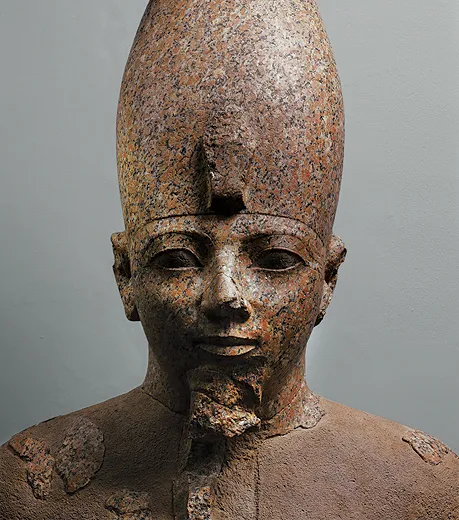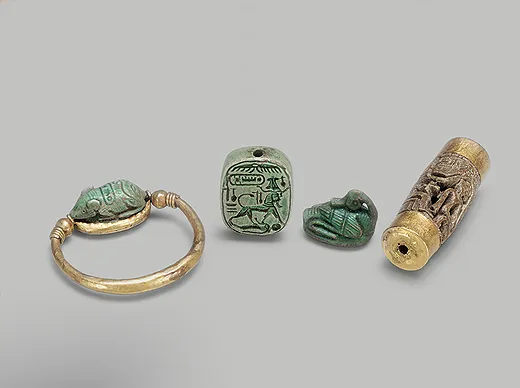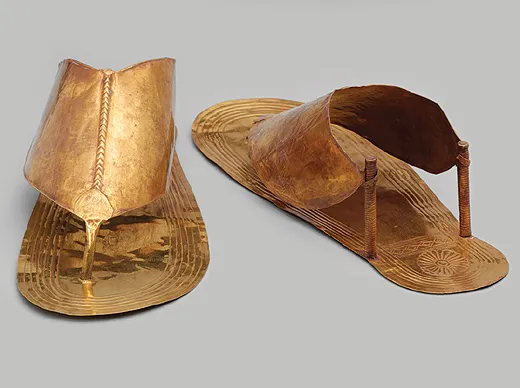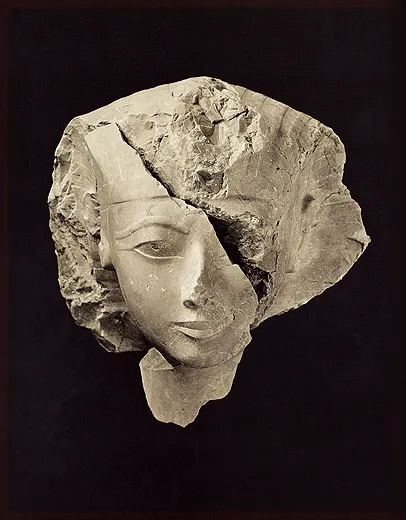The Queen Who Would Be King
A scheming stepmother or a strong and effective ruler? History’s view of the pharaoh Hatshepsut changed over time
Editor’s Note: This article was adapted from its original form and updated to include new information for Smithsonian’s Mysteries of the Ancient World bookazine published in Fall 2009.
It was a hot, dusty day in early 1927, and Herbert Winlock was staring at a scene of brutal destruction that had all the hallmarks of a vicious personal attack. Signs of desecration were everywhere; eyes had been gouged out, heads lopped off, the cobra-like symbol of royalty hacked from foreheads. Winlock, head of the Metropolitan Museum of Art’s archaeological team in Egypt, had unearthed a pit in the great temple complex at Deir el-Bahri, across the Nile from the ancient sites of Thebes and Karnak. In the pit were smashed statues of a pharaoh—pieces “from the size of a fingertip,” Winlock noted, “to others weighing a ton or more.” The images had suffered “almost every conceivable indignity,” he wrote, as the violators vented “their spite on the [pharaoh’s] brilliantly chiseled, smiling features.” To the ancient Egyptians, pharaohs were gods. What could this one have done to warrant such blasphemy? In the opinion of Winlock, and other Egyptologists of his generation, plenty.
The statues were those of Hatshepsut, the sixth pharaoh of the 18th dynasty, one of the few—and by far the most successful—women to rule Egypt as pharaoh. Evidence of her remarkable reign (c. 1479-1458 b.c.) did not begin to emerge until the 19th century. But by Winlock’s day, historians had crafted the few known facts of her life into a soap opera of deceit, lust and revenge.
Although her long rule had been a time of peace and prosperity, filled with magnificent art and a number of ambitious building projects (the greatest of which was her mortuary, or memorial, temple at Deir el-Bahri), Hatshepsut’s methods of acquiring and holding onto power suggested a darker side to her reign and character. The widowed queen of the pharaoh Thutmose II, she had, according to custom, been made regent after his death in c. 1479 b.c. to rule for her young stepson, Thutmose III, until he came of age. Within a few years, however, she proclaimed herself pharaoh, thereby becoming, in the words of Winlock’s colleague at the Metropolitan, William C. Hayes, the “vilest type of usurper.” Disconcerting to some scholars, too, was her insistence on being portrayed as male, with bulging muscles and the traditional pharaonic false beard—variously interpreted by those historians as an act of outrageous deception, deviant behavior or both. Many early Egyptologists also concluded that Hatshepsut’s chief minister, Senenmut, must have been her lover as well, a co-conspirator in her climb to power, the so-called evil genius behind what they viewed as her devious politics.
Upon Hatshepsut’s death in c. 1458 b.c., her stepson, then likely still in his early 20s, finally ascended to the throne. By that time, according to Hayes, Thutmose III had developed “a loathing for Hatshepsut...her name and her very memory which practically beggars description.” The destruction of her monuments, carried out with such apparent fury, was almost universally interpreted as an act of long-awaited and bitter revenge on the part of Thutmose III, who, Winlock wrote, “could scarcely wait to take the vengeance on her dead that he had not dared in life.”
“Of course, it made a wonderful story,” says Renée Dreyfus, curator of ancient art and interpretation at the Fine Arts Museums of San Francisco. “And this is what we all read when we were growing up. But so much of what was written about Hatshepsut, I think, had to do with who the archaeologists were...gentlemen scholars of a certain generation.”
Hatshepsut was born at the dawn of a glorious age of Egyptian imperial power and prosperity, rightly called the New Kingdom. Her father, King Thutmose I, was a charismatic leader of legendary military exploits. Hatshepsut, scholars surmise, may have come into the world about the time of his coronation, c. 1504 b.c., and so would still have been a toddler when he famously sailed home to Thebes with the naked body of a Nubian chieftain dangling from the prow of his ship—a warning to all who would threaten his empire.
Hatshepsut seems to have idolized her father (she would eventually have him reburied in the tomb she was having built for herself) and would claim that soon after her birth he had named her successor to his throne, an act that scholars feel would have been highly unlikely. There had been only two—possibly three—female pharaohs in the previous 1,500 years, and each had ascended to the throne only when there was no suitable male successor available. (Cleopatra would rule some 14 centuries later.)
Normally, the pharaonic line passed from father to son—preferably the son of the queen, but if there were no such offspring, to the son of one of the pharaoh’s “secondary,” or “harem,” wives. In addition to Hatshepsut—and another younger daughter who apparently died in childhood—it’s believed that Thutmose I fathered two sons with Queen Ahmes, both of whom predeceased him. Thus the son of a secondary wife, Mutnofret, was crowned Thutmose II. In short order (and probably to bolster the royal bloodlines of this “harem child”), young Thutmose II was married to his half sister Hatshepsut, making her Queen of Egypt at about age 12.
Historians have generally described Thutmose II as frail and ineffectual—just the sort of person a supposedly shrewish Hatshepsut could push around. Public monuments, however, depict a dutiful Hatshepsut standing appropriately behind her husband. But while she bore her husband a daughter, Neferure (her only known child), Hatshepsut failed in the more important duty of producing a son. So when Thutmose II died young (c. 1479 B.C.), possibly still in his 20s—the throne went, yet again, to a “harem child.” Duly named Thutmose III, this child was destined to become one of the great warrior kings of Egypt. But at the time of his father’s death, he was likely an infant, a “hawk...still in the nest”—and deemed too young to rule.
In such cases, it was accepted New Kingdom practice for widowed queens to act as regents, handling the affairs of government until their sons—in this case, stepson/nephew—came of age, and Hatshepsut (more or less automatically, it seems) got the assignment. “I think it would have been pretty much the norm for Hatshepsut to step in,” says Peter Dorman, an Egyptologist who is president of the American University of Beirut. “But it’s also quite clear that Thutmose III was recognized as king from the very start.”
Monuments of the time show Thutmose III—still a child, but portrayed in the conventional manner as an adult king—performing his pharaonic duties, while Hatshepsut, dressed as queen, stands demurely off to one side. By the seventh year of her regency, however (and it may have been much earlier), the formerly slim, graceful queen appears as a full-blown, flail-and-crook-wielding king, with the broad, bare chest of a man and the pharaonic false beard.
But why? To Egyptologists of an earlier generation, Hatshepsut’s elevation to godlike status was an act of naked ambition. (“It was not long,” Hayes wrote, “before this vain, ambitious, and unscrupulous woman showed...her true colors.”) But more recent scholarship suggests that a political crisis, such as a threat from a competing branch of the royal family, obliged Hatshepsut to become pharaoh. Far from stealing the throne, says Catharine Roehrig, curator of Egyptian art at the Metropolitan Museum in New York City, “Hatshepsut may have had to declare herself king to protect the kingship for her stepson.”
It’s an interpretation that seems to be supported by Hatshepsut’s treatment of Thutmose III during her reign. “He wasn’t under house arrest for those 20-odd years,” says Roehrig. “He was learning how to be a very good soldier.” And it’s not as if Hatshepsut could have stepped down when her stepson came of age. “Once you took on the attributes of kingship,” explains Dreyfus, “that was it. You were a god. It’s not queen for a day, it’s king for all time.”
Hatshepsut probably knew her position was tenuous—both by virtue of her sex and the unconventional way she had gained the throne—and therefore appears to have done what canny leaders have often done in times of crisis: she reinvented herself. The most obvious form this took was having herself portrayed as a male pharaoh. As to why, “No one really knows,” says Dorman. But he believes it may have been motivated by the presence of a male co-ruler—a circumstance with which no previous female ruler had ever contended.
“She was not pretending to be a man! She was not cross-dressing!” Cathleen Keller, a professor of Near Eastern studies at the University of California at Berkeley, told me before her death last year. Inscriptions on Hatshepsut’s statues, she said, almost always contain some indication of her true gender—a title, such as “Daughter of Re,” or feminine word endings, resulting in such grammatical conundrums as “His Majesty, Herself.”
Hatshepsut also took a new name, Maatkare, sometimes translated as Truth (maat) is the Soul (ka) of the Sun God (Re). The key word here is maat—the ancient Egyptian expression for order and justice as established by the gods. Maintaining and perpetuating maat to ensure the prosperity and stability of the country required a legitimate pharaoh who could speak—as only pharaohs could—directly with the gods. By calling herself Maatkare, Hatshepsut was likely reassuring her people that they had a legitimate ruler on the throne.
One important way pharaohs affirmed maat was by creating monuments, and Hatshepsut’s building projects were among the most ambitious of any pharaoh’s. She began with the erection of two 100-foot-tall obelisks at the great temple complex at Karnak. Reliefs commemorating the event show the obelisks, each weighing about 450 tons, being towed along the Nile by 27 ships manned by 850 oarsmen.
Hatshepsut carried out her public works program across the empire, but it was concentrated in the area around Thebes, the dynastic and theological center of the Thutmoside dynasty, where she built a network of imposing processional roadways and sanctuaries. At Deir el-Bahri, just across the Nile from Thebes, she erected her magnum opus—an immense memorial temple, used for special religious rites connected to the cult that would guarantee Hatshepsut perpetual life after death.
Dramatically sited at the base of towering limestone cliffs, the temple, which is regarded as one of the architectural wonders of the ancient world, is approached through a series of terraced colonnades and courtyards that appear to ascend up the very side of the mountain. Despite the enormous scale of the complex—roughly the length of two and a half football fields—its overall impression is one of lightness and grace, unlike the fortresslike temples of her predecessors.
The temple’s lower levels featured pools and gardens planted with fragrant trees. Supersized images of Hatshepsut were everywhere. Some 100 colossal statues of the female pharaoh as a sphinx guarded the processional way. Lining the terraces were more images of the ruler (some more than ten feet tall) in various devotional attitudes—kneeling with offerings to the gods, striding into eternity or in the guise of Osiris, god of death and resurrection. Miraculously, a number of these statues—some reassembled, others still in a fragmentary state—survive. Most are massive, masculine and meant to be seen from a distance.
Hatshepsut’s temple also featured a series of reliefs marking the achievements of her reign, including a storied trading expedition to the mysterious and distant land called Punt, believed to be somewhere on the coast of the Red Sea, perhaps in current-day Eritrea. The reliefs show the Egyptians loading their boats in Punt with an array of highly prized luxury goods—ebony, ivory, gold, exotic animals and incense trees. “Never,” reads an inscription, “were such things brought to any king since the world was.”
As a work of art, of architecture and of self-glorification, Hatshepsut’s memorial was an enormous enterprise that must have involved an army of workers. It’s almost certain, scholars agree, that Senenmut, the official overseer of works at Deir el-Bahri, was the mastermind behind—if not the actual architect of—the temple. He had most likely begun his climb to power during the reign of Thutmose II, when he was appointed tutor to Hatshepsut’s daughter, Neferure. But his influence soared with Hatshepsut’s accession to the throne. In time he acquired some 93 titles, the most prestigious of which was Great Steward of Amun (the god of Thebes), which put him in charge of all of Karnak’s building and business activities.
Many of Senenmut’s monuments to himself (some 25—a staggering number for a nonroyal) mention his exceptional access to the throne; he was a “true confidant” of the pharaoh and the “one upon whose utterances his Lordrelied.” But earlier scholars’ belief that Senenmut was the real force behind Hatshepsut’s rule—not “even a woman of the most virile character could have attained such a pinnacle of success without masculine support,” wrote historian Alan Gardiner in 1961—has now been largely discounted by experts as a woeful underestimation of Hatshepsut.
Did she and Senenmut share more than power? Probably not, most scholars, including Peter Dorman, have concluded. Dorman does believe, however, that the pharaoh and her favorite minister may well have been victims ofspeculation and gossip.
Senenmut’s fate is a mystery. His privileged position allowed him to build a splendid tomb for himself near Hatshepsut’s—which is in the Valley of the Kings, just west of Deir el-Bahri—but he apparently never occupied it. The tomb suffered major damage, including the smashing of his impressive, if unused, stone sarcophagus. It was long thought that either Hatshepsut or Thutmose III were the culprits, but recent scholarship suggests some combination of religious upheaval, tomb robbers and natural collapse.
Hatshepsut’s own tomb was cut into the base of the cliffs on the east side of the Valley of the Kings and was large enough to accommodate both her sarcophagus and that of her father—reburying him in her tomb was yetanother attempt to legitimize her rule. It’s believed that Hatshepsut died (possibly in her late 40s) around 1458 b.c., the year that Thutmose III first used the title “Ruler of Maat.”
Thutmose III’s destruction of Hatshepsut’s monuments has long been recognized as a conscientious—and very nearly successful—attempt to obliterate her name and memory from history. But was it, as many early Egyptologists had assumed, an act of revenge and hatred? In recent decades, scholars have re-examined the archaeological evidence and come to the startling conclusion that the destruction, presumed to have been initiated soon after Hatshepsut’s death, was actually not begun until some 20 years later, toward the end of Thutmose III’s own long reign (c. 1458-1425 b.c.). “I think that people recognize now, because it happenedso late in Thutmose III’s reign, that it wasn’t personal animosity,” says Dorman of the rampage. “For some reason, Thutmose III must have decided it was necessary to essentially rewrite the official record of Hatshepsut’s kingship”—which meant eradicating all traces of it to suggest that the throne had gone directly from his father to him.
While numerous theories abound, most contemporary Egyptologists agree that the effort to delete Hatshepsut’s rule had something to do with Thutmose III’s concerns about the succession of power after his death. Wasthere some threat to the legitimacy of his own son, Amenhotep II, who in fact did succeed him? Possibly. But Dorman believes that Hatshepsut’s unconventional reign may have been too successful, a dangerous precedent “best erased,” he suggests, “to prevent the possibility of another powerful female ever inserting herself into the long line of Egyptian male kings.”
The story of Hatshepsut will probably never be complete. “She’s like an iceberg,” says Joyce Tyldesley, scholar and author of the 1996 biography Hatchepsut: The Female Pharaoh. “On the surface we know quite a lot about her. But there’s so much we don’t know.”
Even so, new light continues to shine on the queen who would be king. In 2007, Egyptian archaeologist Zahi Hawass identified a previously excavated royal mummy as Hatshepsut. Catharine Roehrig is among those scholars awaiting more evidence to bolster the claim. “The fact that the mummy is female, was found in the Valley of the Kings and is about the right age makes this identification quite possible,” she says. But, Roehrig adds, “The evidence is not conclusive; further studies are in progress.”
Tyldesley believes that Hatshepsut may have been keenly conscious of her exceptional place in history. “This is just speculation,” she says, “but I think she was almost aware that she might be forgotten or that her actions would be misunderstood.” Toward the end of her reign, Hatshepsut erected a second pair of obelisks at Karnak. On one the inscription reads: “Now my heart turns this way and that, as I think what the people will say—those who shall see my monuments in years to come, and who shall speak of what I have done.”




